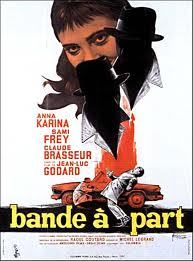Director: Jean-Luc Godard (1964)
 There is never going to be enough space in the confines of a blog that could contain the joy that fills my heart when I see this film. Or any Godard film for that matter. My once passable French language skills have vastly depleted after favouring Spanish at university and while travelling but whenever I watch this film, or À bout de souffle for that matter, all I want to do is put on a striped polo neck dress, cut my fringe that little bit too short and run down the Left Ban holding hands with a beautiful Frenchman in a camel coat… It is a very specific fantasy.
There is never going to be enough space in the confines of a blog that could contain the joy that fills my heart when I see this film. Or any Godard film for that matter. My once passable French language skills have vastly depleted after favouring Spanish at university and while travelling but whenever I watch this film, or À bout de souffle for that matter, all I want to do is put on a striped polo neck dress, cut my fringe that little bit too short and run down the Left Ban holding hands with a beautiful Frenchman in a camel coat… It is a very specific fantasy.
Bande a Part is probably one of Godard’s most well known films, a lot of this is probably due to Quentin Tarantino’s advocation of the film, to the extent that he pays homage to the film in the name of his production company ‘Band Apart’ and in the now infamous Uma Thurman/John Travolta dance scene in Pulp Fiction.
The story itself is a beautifully simple one, Arthur (Claude Brasseur) and Franz (Sami Frey), both hopelessly infatuated with the breathtakingly beautiful Odile (Anna Karina) draw her into their would-be criminal masterplan to steal a secret stash of money Odile found in her Aunt Victoria’s house. The devious boys persuade her to help them rob the house. The actual robbery takes place at the end of the film and with minimal preparation necessary, the rest of the film can be devoted to what I believe Godard does best, creating a set of wonderfully intricate characters and their intertwined relationships with one another- all set to a typically Parisien backdrop and a jazz/soul infused soundtrack.
I think it is for this reason that Bande a Part is not so much known for its riveting plot but rather as a sum of its parts with some of the most iconic and referenced scenes in cinema, not just the French New Wave. The three hold a one minute silence in a cafe, and while they only last 36 seconds, the soundtrack is stopped and we too join the silence watching as Arthur and Franz both stare at Odile- this simple action perfectly vocalises how words and mood music are competely irrelevant when a person’s face is sufficient to voice what they are feeling.
Perhaps my favourite scene, and I am accepting that I am a complete cliche now, is the Madison scene where the three effortlessly perform a dance routine in the middle of the cafe. Again, while there is no dialogue, a gentle brush of Odile’s back, a glance over the shoulder tied with the narrator’s insight lets us feel what the character’s are all thinking during their impromptu dance. What could so easily have been a gratutious and misplaced dance number (see Spiderman 3) becomes a necessary development in their relationship.
Similarly, I have never been to the Louvre without having an underlying urge to burst into a sprint in an attempt to join the ranks of those who have seen everything in nine minutes and 43 seconds. Unfortunately I am by no means graceful (or brave) enough to attempt this and so instead I have to relish watching Arthur, Franz and Odile’s joy as they fling themselves around the gallery evading security and navigating the slippery marble floors- a joy that is also emulated in The Dreamers. 
Bande a Part is one of those films that leaves a mark, the fact that is has been embraced by so many other film makers in their own work speaks as loudly as the silent stares in the one minute silence pays testament to this. With a soundtrack, cast, script and cinematography that still acts as a reference sheet for French New Wave cinema, it is an untouchable film, you can copy it and pay your own homage to its scenes whether it be a gentle acceleration of pace through an art gallery or the more blatant devotion with impromptu dance routines in public places, but we will never be able to replicate the beauty with which Godard saw the world through his camera.




I love this film — and that now cliché spontaneous dance — I want to done a funny sweater and prance around Europe with a girl like Odile. On a more serious note, I think Band a Part shows Godard at his most visually interesting feature — something he doesn’t always succeed at.
A wonderful review! Thank you 🙂